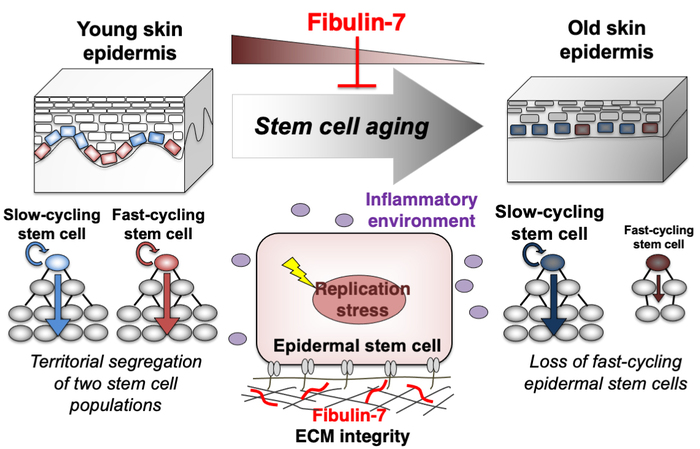- HOME
- News & Events
- Publications
- 【Publications】The extracellular matrix fibulin 7 maintains epidermal stem cell heterogeneity during ...
Publications
【Publications】The extracellular matrix fibulin 7 maintains epidermal stem cell heterogeneity during skin aging
October 24 2022
Lab: Aiko Sada
Paper information
Title:
The extracellular matrix fibulin 7 maintains epidermal stem cell heterogeneity during skin aging
Erna Raja, Gopakumar Changarathil, Lalhaba Oinam, Jun Tsunezumi, Yen Xuan Ngo, Ryutaro Ishii, Takako Sasaki, Kyoko Imanaka-Yoshida, Hiromi Yanagisawa, Aiko Sada
EMBO Reports doi: 10.15252/embr.202255478 URL: https://www.embopress.org/doi/10.15252/embr.202255478
Highlights:
- During chronological aging, fast-cycling epidermal stem cells are gradually lost and the compartment of distinct stem cell populations is impaired.
- Loss of fibulin 7 promotes epidermal stem cell aging with heightened response to aging-related inflammation and impaired wound healing.
- Gain-of-function of fibulin 7 inhibits proliferation and differentiation of epidermal stem cells.
- Fibulin 7 binds to other ECM molecules and impacts the basement membrane components.
Abstract:
Tissue stem cells divide infrequently as a protective mechanism against internal and external stresses associated with aging. Here, we demonstrate that slow- and fast-cycling stem cells in the mouse skin epidermis undergo distinct aging processes. Two years of lineage tracing reveals that Dlx1+ slow-cycling clones expanded into the fast-cycling stem cell territory, while the number of Slc1a3+ fast-cycling clones gradually declined. Transcriptome analysis further indicated that the molecular properties of each stem cell population are altered with age. Mice lacking fibulin 7, an extracellular matrix (ECM), show early impairments resembling epidermal stem cell aging, such as the loss of fast-cycling clones, delayed wound healing, and increased expression of inflammation- and differentiation-related genes. Fibulin 7 interacts with structural ECM and matricellular proteins, and the overexpression of fibulin 7 in primary keratinocytes results in slower proliferation and suppresses differentiation. Thus, these results suggest that fibulin 7 plays a crucial role in maintaining tissue resilience and epidermal stem cell heterogeneity during skin aging.

